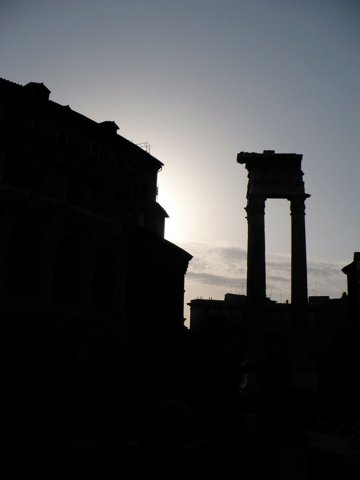
The last few hours of daylight of my last day in Rome were upon me. So, sadly, I couldn’t linger in the forum — there was still so much to see!

On top of the Capitoline Hill (the centre of religious life in ancient Rome) is the Piazza del Campidoglio, a space designed by Michaelangelo. There are three palazzi on its edges: this one, the Palazzo Senatorio, is Rome’s town hall. It was built in the 13th century, though the facade is from the late 16th (and the twin staircases are by Michaelangelo). The resting place for the birds is a replica of an equestrian statue of Marcus Aurelius which stood here for several centuries (see below).
The other two palazzi are occupied by the Musei Capitolini, the Capitoline Museums. Their history can be traced back to 1471, when Pope Sixtus IV donated what are still some of its most impressive artefacts to the people of Rome (though it seems they weren’t actually allowed to see them for about three hundred years) and housed them on the Capitoline. 1471! That’s ZOMG-worthy in and of itself. But there are far more ZOMGs to come.
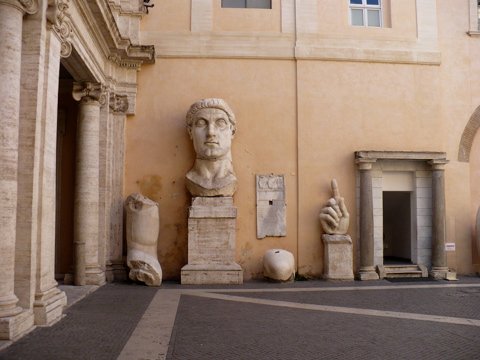
These aren’t part of the original collection: they have only been in the museum for 522 years. They are marble fragments of a colossal statue of Constantine which originally stood (or sat, rather, as he was enthroned) in the Basilica of Maxentius.

The original statue (the torso was made of brick, wood and possibly bronze, and has not survived) was about 12 metres high. Here’s how Con would have appeared from the vantagepoint of one of his citizens in the early 4th century.

A newly-restored bronze equestrian statue, sans rider, which is Greek and either 5th- or 4th-century BC. It may even have been carved by one of the great sculptors of antiquity, Phidias, if this USA Today article is to be believed. (Well, it’s probably no worse than Wikipedia …)

This is the equestrian bronze of Marcus Aurelius which used to stand in the piazza. Notice the lack of stirrups — the Romans didn’t have ’em.
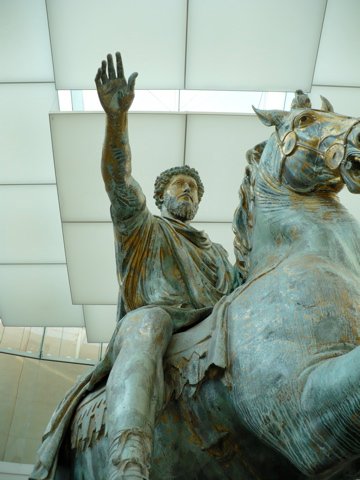
It’s apparently the only full-size bronze of an emperor to have survived, as in the Middle Ages they tended to be melted down to make more useful things. The pagan philosopher Marcus was spared, it is said, because he was confused with Constantine, the first Christian emperor. Seems a bit unlikely when you look at the clean-shaven Constantine above … but whatever the reason, we can be grateful that it has survived.

Probably the museum’s most famous artefact out of an incredibly iconic collection: the Capitoline Wolf, a bronze statue of the she-wolf who, according to Rome’s founding myth, suckled the infant Romulus and Remus. (Their figures were added in the 15th century.) It’s not just any statue, either: it was famous enough for both Cicero and Pliny the Elder to write about it. That is, assuming it is the same statue — two Italian scholars claimed recently that it may have been cast in the middle ages. (Bloody historians, they are no fun at all.) Otherwise, it’s Etruscan and dates to 500 BC or so.

Also mentioned by Pliny is this Hercules, which originally stood in the Temple of Hercules Victor, by the Tiber (and which I didn’t know about when I was only 200 metres from the place!)

And the hits keep on coming: fragments of another colossal statue of Constantine, bronze this time. Part of the original collection (thanks, Sixtus!)

A life-size dog, found near the auditorium of Maecenas, a patron of the arts. Whether this has anything to do with him, I don’t know, but it’s probably safe to assume that whoever commissioned it was a dog person.

Connecting the two palazzi of the Museum is a tunnel running past the ancient state records archives, which has some interesting bits and pieces in it, but the best thing about it is the view of the Roman Forum. From the left: the Arch of Septimius Severus, the tiny Arch of Titus, the Column of Phocas, the Palatine.

Marforio, one of Rome’s five talking statues — a place where, during the Renaissance, popular dissent could be expressed by sticking up satrical poems and the like. He now resides (reclines) in the second of the museum’s palazzi. Originally (i.e. during the 1st century) he represented the god Oceanus.
 .
.
Another really, really, really famous piece, the Dying Gaul. I hadn’t really thought about it, but I guess I sort of assumed he was one of Vercingetorix’s mob. He’s actually a Galatian warrior, one of a large group of Gauls who managed to make it to central Anatolia, in what is now Turkey. It’s a Roman copy of a Hellenistic original from the 3rd century BC.

Dying with dignity.
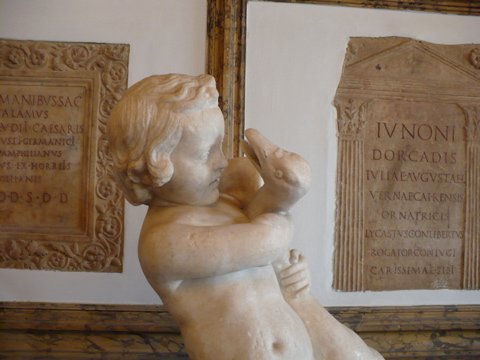
Rather more cheerful is this boy playing with a goose. Unless it’s a copy of a statue made by Boethus, mentioned by Pliny: in that case, he’s strangling it.
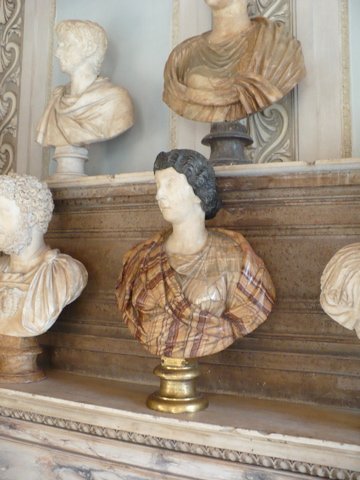
If I squint the right way, it looks like the bust in the middle is of Lucilla, daughter of Marcus Aurelius, brother of Commodus, old flame of Russell Crowe. But the interesting thing is the colours — it’s made from at least four types of marble — and in particular the stripes. How did the sculptor do that? Are they just painted on? Has the marble been stained somehow? Not for the first time I find myself wishing I’d lashed out on the beautiful and massive museum catalogue!

I have no idea who she was …

… but this is the Capitoline Venus. Presumably as a concession to her modesty, she has a room all to herself. Compare with the Campo Iemini Venus in the British Museum.

Hey, you’re supposed to appreciate her from all angles, that’s why she’s in the middle of an octagonal room! And compare with Aphrodite Kallipygos. I think the latter wins out, actually — purely on artistic merit, you understand.
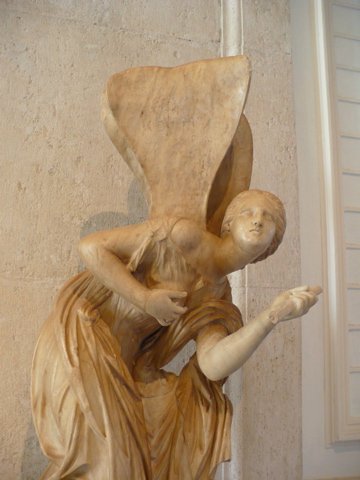
Once again, I must confess my ignorance of this statue’s identity. Nike/Victoria? Nemesis? Iris?
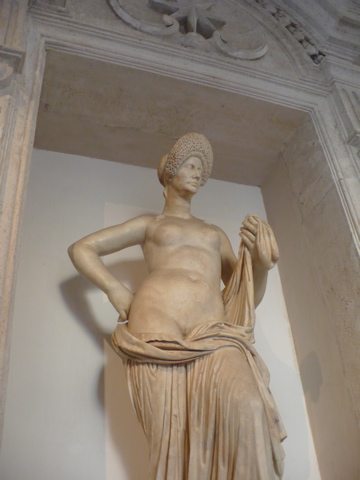
Now, this statue fascinated me. Who it represents is unknown, other than a Roman matron from the Flavian period. The head is clearly a portrait of a real person, not idealised (though the body probably is). Judging from her face, she’s past the first bloom of youth, but confident enough to display her mostly-naked body and perhaps even disdainful of the viewer’s reaction. What would she do with such a statue? Is it something you’d put in the atrium to greet visitors? Or keep it in private for the pleasure of a privileged audience? I’d love to know the story behind this one.

This small boy is definitely strangling the snake, because he’s the infant Hercules, defending himself against Juno’s assassin.
That’s it for the Capitoline Museum. It’s an amazing collection, not as big or diverse as the British Museum’s, but possibly of even higher quality overall (at least if you like Roman stuff. Which I do).

Probably everyone does a little double-take when they see this — it seems familiar somehow, have I taken a wrong turn? It’s not the Colosseum, of course, but the Theatre of Marcellus, inaugurated by Augustus in 12 BC. It’s been extended by later users — the top level is apartments! (The silhouetted photo at the top of the post shows the theatre as well.)

Nearby is a contemporary structure, the Porticus Octaviae. In antiquity, it contained temples, a library and a curia. Latterly it was the site of a fish market, from medieval times through to the end of the 19th century. I can report that it no longer smells of fish.

I walked past the porticus to the Tiber, to the Pons Fabricius, the second-oldest intact bridge in Rome (I think so — the Milvian Bridge is older). The faces on the pillar belong to Janus.

The inscription reads:
L FABRICIVS C F CVR VIAR
FACIVNDVM COERAVIT
Q LEPIDVS M F M LOLLIVS M F COS
Don’t ask me what it means, except that Q. Lepidus and M. Lollius were evidently the consuls in the year the bridge was finished (i.e. 62 BC).

Looking north along the Tiber. On the left is Tiber Island, or Isola Tiberina, the site of a temple to Aesculapius the healer in antiquity, and the location of an antimatter bomb in a Dan Brown novel, according to Wikipedia.

By now I was very tired and footsore, hot and sweaty. I could have tried to find a few more sights to cross off my list, or wandered around one of the many museums, or even gone back to the Roman Forum to see what it looked like at dusk. But to be honest, all I could think of now was getting back to the hotel and flopping down on the bed. Which was half-way across the city. Cursing the ubiquitous Roman cobblestones, I rested in the Largo dei Librai, very near the site of the (long gone) Theatre of Pompey, where Julius Caesar was assassinated. Squashed into the angle between two buildings is this tiny church, Santa Barbara dei Librai (St. Barbara of the Books), founded in the 11th century and rebuilt in 1680.

Nearby is the Campo de’ Fiori. The papal rulers of Rome used this space to carry out executions, and it was on this spot on 17 February 1600 that Darth BrunoGiordano Bruno was burnt at the stake for heresy. (DID YOU KNOW: the call sign of the popular Sydney radio station 2GB is named for Bruno, because its original owners were theosophists who held him in high regard.)
And then I eventually got back to the hotel, packed my bags, got a good night’s sleep, and after another day or so got back to Australia (via Heathrow and Hong Kong).
This concludes my series of posts on my 2007 trip to Britain and Italy!
![]() This work is licensed under a Creative Commons Attribution-NonCommercial-NoDerivatives 4.0 International License.
Permissions beyond the scope of this license may be available at http://airminded.org/copyright/.
This work is licensed under a Creative Commons Attribution-NonCommercial-NoDerivatives 4.0 International License.
Permissions beyond the scope of this license may be available at http://airminded.org/copyright/.


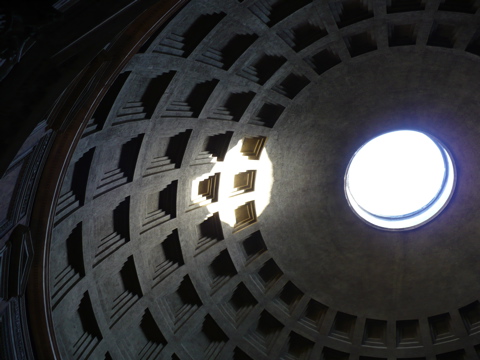
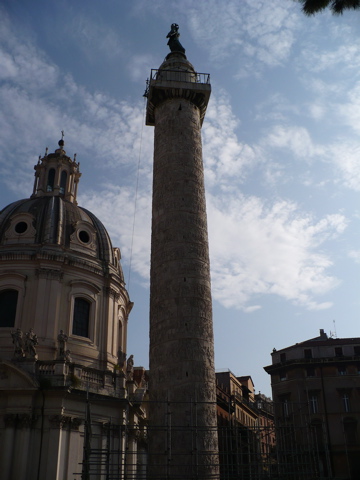
In regards to the Flavian matron statue: This would have been a funerary offering for the deceased woman, whose portrait serves as the face for this statue. In ancient Rome, it was customary for middle class families (and even freedmen) to erect such statues in commemoration of their wives and mothers. Her middle-aged, less-than-perfect face suggests that she was a good wife and mother, who took raising her children and managing her household seriously. The idealized body, however, is a way of alluding to her ability to bear many healthy children, and her ability to fulfill other wifely duties. These would have been placed within tombs that ran along places like the Appian Way, and would probably have only been seen by the family of the deceased. She is quite interesting, though!
Your photos are fabulous and I really appreciated looking at them. Also, thank you for giving me an excuse to finally use my degrees for good; I majored in art history and classics as an undergrad, specializing in Roman sculpture. Thanks again for the images!
Thanks for that information, Katie! I did hope some classicist would come along and fill me in :)
Rome is an easy city to photograph, so it’s not much credit to me. But a pic I took of the Aurelian column is going to appear in a book published by OUP, which pleases my ego, I have to say! (I’m sure the fact that I didn’t charge anything for it helped too …)
I’ll look for it! It’s a shame it always comes down to money, but at least you’re famous now :).
In regards to the Roman Matron statue, Katie is not quite right. Yes, she is a Roman matron; her likeness to Marcia Furnilla is uncanny, especially in the hairstyle. However, this statue was by no means erected by a middle-class or freed family. Given that it is sculpted from high quality marble, it would have been too expensive for anyone but the aristocracy. The hair is also indicative of this, as she is likening herself to the women in the imperial family at the time.
Her face is meant to depict only one thing: her face. This is veristic portraiture, displaying the deceased as she actually was in life, at least with regards to the face. The body, however, is idealized because it is that of a goddess, most likely Venus. Romans would syncretize their images with those of deities upon death in order to raise their own status. The statue itself may have been placed above her tomb, although certainly not in it. It could also have been displayed in a public space for all to see.
Thanks much for that, Chris. The bit about the idealised body makes sense.